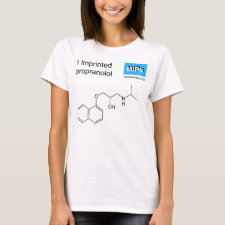
Authors: Suedee R, Naklua W, Laengchokshoi S, Thepkaue K, Pathaburee P, Nuanplub M
Article Title: Investigation of a self-assembling microgel containing an (S)-propranolol molecularly imprinted polymer in a native tissue microenvironment: Part I. Preparation and characterization.
Publication date: 2015
Journal: Process Biochemistry
Volume: 50
Issue: (4)
Page numbers: 517-522.
DOI: 10.1016/j.procbio.2015.01.003
Alternative URL: http://www.sciencedirect.com/science/article/pii/S1359511315000045
Abstract: In this study, we have developed a molecularly imprinted polymer (MIP) selective for (S)-propranolol that was encapsulated within an assembled gel, and allowed for an induced interaction in a live tissue environment. The development of the MIP microparticles having assembled nanoparticles with separated domains at their outer shell involved an assessment of the selectivity of the template and the morphology of its surface, using single and mixed crosslinking agents. The MIPs resulted in differential rebinding of the template, governed by different crosslinked architectures of the resulting polymer. The strength of the interaction of that shape molecule with the adaptable properties in the pore-wall of recognition site, especially an MIP that was prepared using a mixed crosslinker on lining silicone membrane, influenced high enantioselectivity in the gel. A different configuration response of the MIP embedded responsive gel enabled drug shaping, and affected generating the intrinsic recognition for an increase of the macromolecular proximity and dynamic interactions in the excised skin. Overall, the MIPs in a self-assembled microgel may show a potential for the study of integrated biological systems, with pharmaceutical and even therapeutic applications
Template and target information: (S)-propranolol, propranolol
Author keywords: Molecularly imprinted polymers, self-assembly, chiral, Selective patterned surface, Site-specific affinity



Join the Society for Molecular Imprinting

New items RSS feed
Sign-up for e-mail updates:
Choose between receiving an occasional newsletter or more frequent e-mail alerts.
Click here to go to the sign-up page.
Is your name elemental or peptidic? Enter your name and find out by clicking either of the buttons below!
Other products you may like:
 MIPdatabase
MIPdatabase









